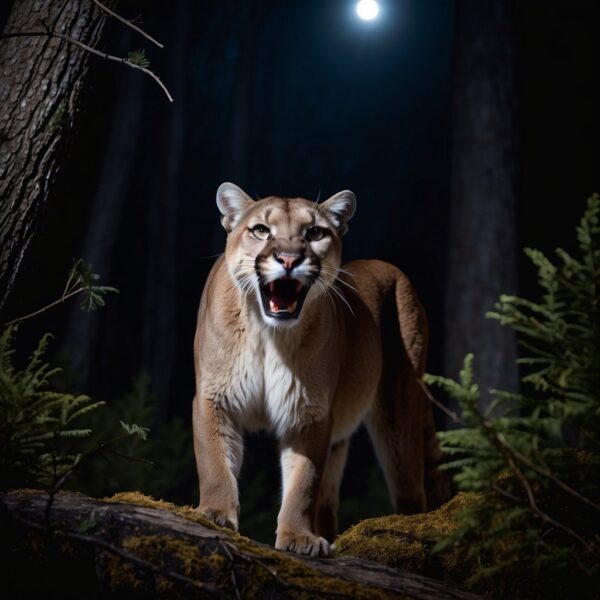
Cougar Scream: High Pitched Eerie Echo
The mountain lion’s scream is a sound that stops many in their tracks. This distinctive call is often likened to a human’s scream, and it has a penetrating, high-pitched quality that can be both startling and unnerving. When heard in the wild, it serves as a profound reminder of the untamed essence of nature and the presence of these majestic predators. The cry of a mountain lion, aside from being a form of communication, has evolved to fulfill various functions within their behavior, including mating calls and territorial signals.
Understanding the vocalizations of mountain lions is crucial for both appreciating these big cats and for staying safe in areas where they roam. While not commonly seen due to their elusive nature, mountain lions are a vital part of the ecosystem, fulfilling the role of a top predator. Their bone-chilling scream, while fascinating, is just one aspect of their complex behavior. Their biology and various behaviors, including their vocalizations, are key to identifying their presence and are integral to efforts in conservation and fostering coexistence between humans and mountain lions.
Key Takeaways
- The mountain lion’s scream is a distinctive call that functions in mating and territorial signaling.
- Awareness of mountain lion vocalizations assists in species appreciation and in ensuring human safety.
- Accurate knowledge of these predators supports conservation efforts and promotes cohabitation strategies.
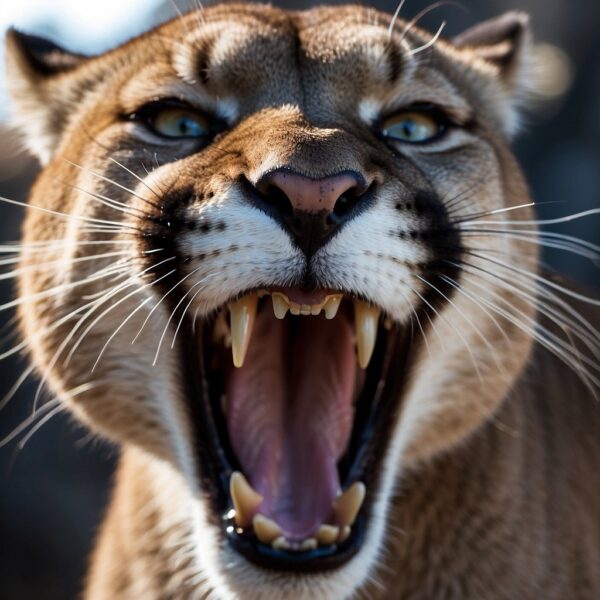
Understanding Mountain Lion Vocalizations
Mountain lions, also known as cougars or pumas, have a repertoire of vocalizations each serving a specific purpose. These sounds play a crucial role in their behavior and interactions with other mountain lions and species.
Variety and Purpose of Sounds
Mountain lions produce a range of vocalizations, such as screams, roars, hisses, and growls. Each sound serves a distinct function:
- Screams: Often associated with mating, these piercing calls can be heard during the breeding season.
- Roars: Typically used to establish territory and deter other mountain lions.
- Hisses and Growls: Serve as warnings or defensive cues against perceived threats.
The specific pitch and tone of these sounds can convey different messages, much like how an owl communicates through a series of hoots with varying frequencies.
Comparing Cougar Cries with Other Wildlife
Comparing mountain lion vocalizations with other wildlife helps highlight their unique acoustic signatures:
- American Alligator: Bellowing roar that establishes dominance and territory.
- Red Fox: High-pitched scream, often mistaken for a human in distress.
- Great Horned Owl: Series of deep hoots, a low-frequency sound used for communication.
- Barred & Barn Owls: Notable for their distinctive calls such as the Barred Owl’s “who cooks for you” sound.
- Great Blue Heron: Produces a harsh croak, markedly different from the mountain lion’s scream.
Understanding these differences is crucial for wildlife enthusiasts and researchers to accurately identify the presence of these animals in the wild based solely on their call.
The Mountain Lion Scream Explained
The sound of a mountain lion scream is often compared to a human’s scream for its startling quality. It serves specific purposes in the wild, signaling communication and territorial claims during key behavioral contexts such as hunting and mating season.
The Mystery Behind the Scream
The scream of a mountain lion is described as bone-chilling, a piercing cry that can seem akin to a scene from a horror movie. This powerful vocalization is multifaceted, with roots in the mountain lion’s evolutionary need to communicate. The scream, particularly intense during mating season, serves as a signal to other mountain lions. Females in heat may scream to announce their readiness for courtship, while males may use the sound as part of their mating rituals.
Scream in Communication and Territoriality
Mountain lions use vocalizations for communication, establishing territory, and during the courtship process. The scream can be heard across great distances, functioning as an audible marker of presence to ward off potential competitors and to establish a mountain lion’s domain during the territorial phase. These vocal exchanges help prevent physical confrontations and maintain social order.
- Territorial: Loud screams signify an individual’s territorial range to others.
- Communication: Scream conveys information about reproductive status and readiness.
Behavioral Context of the Scream
The behavioral context of the mountain lion scream varies:
- Hunting: Rarely associated with a hunt, the scream primarily functions for communication rather than predation.
- Mating Season: Females typically scream when they are in heat, signaling their availability to males.
- Territorial Assertion: Both genders may scream to assert dominance or when threatened.
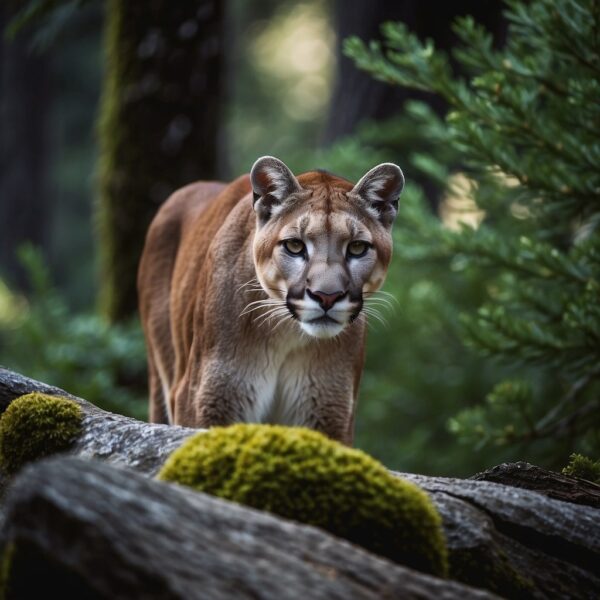
Mountain Lion Biology and Behavior
The mountain lion, often referred to as a cougar or puma, displays various adaptations that facilitate its role as a solitary and effective predator. Its vocalizations, including the infamous scream, reproductive strategies, and hunting methods define its ecological niche.
Physical Adaptations for Sound Production
The mountain lion’s vocal cords are capable of producing a wide range of sounds, from purrs to the bone-chilling scream often associated with its presence. These powerful and distinctive vocalizations are enhanced by a well-developed larynx and large chest cavity, which allow the sounds to resonate. The screams are particularly loud during the mating season, serving as mating calls to attract potential mates.
- Adaptations for sound production:
- Well-developed larynx
- Large chest cavity
- Strong vocal cords capable of loud screams
Reproductive and Social Behavior
Mountain lions were thought to be solitary animals, coming together only for mating. Recent studies with the help of camera traps reveal they big cats might not be solitary after-all. The breeding season triggers notable changes in behavior, marking the time when individuals seek out each other with persistent and loud calls. Mating rituals may involve vocalizations, scent marking, and physical displays. After a gestation period of approximately 90 days, female mountain lions give birth to a litter of cubs.
- Reproductive behavior:
- Breeding season marked by loud calls
- Solitary outside of mating
- Gestation period of around 90 days
Territory and Hunting Practices
Occupying territories that can span hundreds of square miles, mountain lions are skilled hunters that primarily hunt at night. Their retractable claws and strong muscular build allow them to take down a variety of prey, ranging from deer to small mammals. Their acute senses and adaptability enable them to thrive in diverse environments like forests and mountains. They are apex predators, playing a crucial role in controlling prey populations and maintaining ecosystem balance.
- Hunting adaptations:
- Retractable claws for gripping prey
- Strong build for overpowering prey
- Nocturnal hunting habits
Identifying Mountain Lion Presence
Mountain lions are elusive, but certain indicators can reveal their presence in an area. Recognizing these signs is crucial for wildlife enthusiasts, hikers, and residents near mountain lion habitats.
Sight and Sound Clues
Visual and auditory evidence can often signal the presence of mountain lions. They are known for their distinctive vocalizations which include roars, hisses, growling, and hissing, each varying in volume and pitch. Although not frequently heard, a mountain lion’s roar can be a strong, bone-chilling sound that reverberates through their territory.
- Roars: Usually heard during mating season or asserting territory.
- Hisses and Growls: Common when threatened or during feeding.
Listen for these sounds, especially at dawn or dusk, as mountain lions are crepuscular, meaning they are most active during those times.
Physical Evidence of Mountain Lions
Evidence of a mountain lion’s presence can be directly observed through:
- Tracks: Look for paw prints that lack claw marks, as mountain lions have retractable claws. The size of the tracks can help distinguish them from other animals.
- Scat: Their scat is large and segmented and may contain fur or bones from their prey.
- Claw Marks: Trees and other surfaces might bear claw marks from mountain lions sharpening their claws.
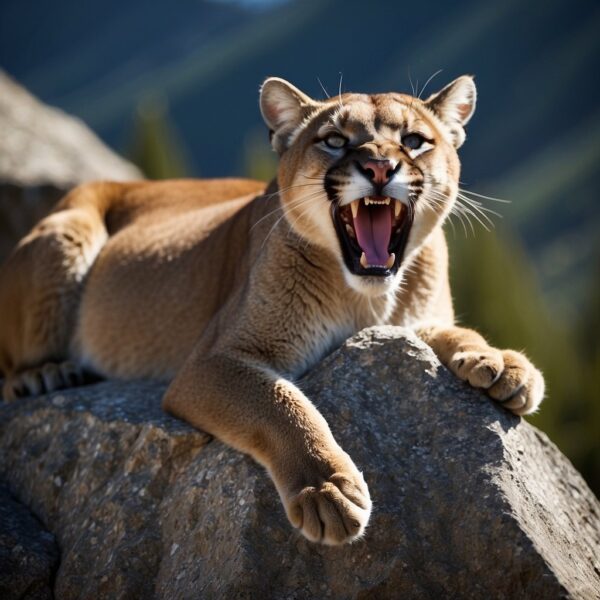
Cultural Impact of the Mountain Lion Scream
The scream of the mountain lion has a profound resonance in culture, often associated with feelings of dread due to its bone-chilling nature. In the domain of film, particularly horror movies, the scream is utilized to evoke an acute sense of fear among audiences, leveraging the sound’s unnerving quality to heighten tension.
Media Representation
- Films and Television: Mountain lion screams are frequently incorporated in soundscapes to create an atmosphere rife with tension and impending doom.
- Music and Soundtracks: Composers occasionally infuse this scream into scores, adding a layer of primal unease.
Psychological Response
- Fear: The scream can trigger instinctive fear responses, a throwback to ancestral experiences where such sounds signified predatory danger.
Folklore and Myth
- Local Legends: Stories and myths sometimes feature the mountain lion’s scream, suggesting its influence extends well into mythical narratives within human societies.
In literature and anecdotes, the mountain lion’s scream is often described using vivid imagery that accentuates its terrifying impact, such as being compared to a woman’s scream. This portrayal cements the sound as a symbol of wilderness and the peril that lurks within it. Consequently, cultural responses to the sound frequently blend respect for the animal’s power with an acknowledgment of the fear such an unpredictable and potent force of nature inspires.
Conservation and Coexistence
The intersection of human populations and mountain lion habitats presents distinct challenges and requires strategic approaches to ensure both conservation of the species and the safety of human communities.
Challenges in Mountain Lion Conservation
Conservation efforts for mountain lions face a set of intricate challenges. These predators, which are critical to the ecosystem, require large territories to thrive. Habitat fragmentation, often due to human development, hinders their ability to roam and hunt, leading to increased encounters with humans. Additionally, misconceptions about mountain lions being an immediate threat can fuel fear and antagonism, prompting lethal control measures that undermine conservation.
Food scarcity due to competition with other predators or the decline in prey populations can also force mountain lions closer to human settlements, in search of sustenance, heightening the potential for conflict. The balance of sustaining wildness in wilderness areas while managing predator populations is a complex aspect of conservation biology that is continually being navigated.
Strategies for Human-Wildlife Harmony
To promote coexistence and conservation, targeted strategies are implemented. Educational outreach plays a critical role, informing communities about mountain lion behaviour and reducing unwarranted fear. Installing wildlife crossing structures like overpasses and underpasses facilitates safe passage for mountain lions across fragmented landscapes.
| Strategy | Description |
|---|---|
| Land-use planning | Incorporating wildlife corridors in development plans. |
| Public education | Promoting understanding of mountain lion behaviour. |
| Non-lethal deterrents | Using measures like guard animals or motion-sensitive lighting. |
Creating legislative protections for mountain lions helps to prevent unnecessary culling and conserves their populations for their ecological roles as a keystone species. Research and monitoring of mountain lion movements and health are crucial for adaptive management, allowing conservationists to respond promptly to emerging challenges in human-wildlife dynamics.
Efforts are continually made to adapt and optimize strategies for peaceful coexistence.
Encountering a Mountain Lion: Safety Tips
When one finds themselves face to face with a mountain lion in the outdoors, safety is of paramount concern. They should remain calm and avoid panic.
Do Not Run: A person’s instinct might be to flee, but running may trigger the mountain lion’s instinct to chase. Instead, they should slowly back away, facing the lion and giving it a path to escape.
Make Yourself Large and Loud: To seem less like prey, one can make themselves appear larger by raising arms, opening jackets, or waving objects. Making loud and firm noises can also deter the lion.
Maintain Eye Contact: While not approaching or running from the lion, maintaining eye contact shows that one is not prey and may help keep the lion at bay.
Protect Children: If there are children present, one should pull them close to prevent the lion from seeing them as easier targets.
| Action | Purpose |
|---|---|
| Do Not Run | Prevents triggering the lion’s chase instinct |
| Make Noise | Can deter the lion |
| Appear Larger | Reduces the impression of being prey |
Fight Back if Attacked: In the unlikely event of an attack, they should use any weapons available, including rocks, sticks, or bare hands, aiming for the lion’s eyes and face.
These protocols are recommended for anyone spending time in areas where these animals are known to roam.
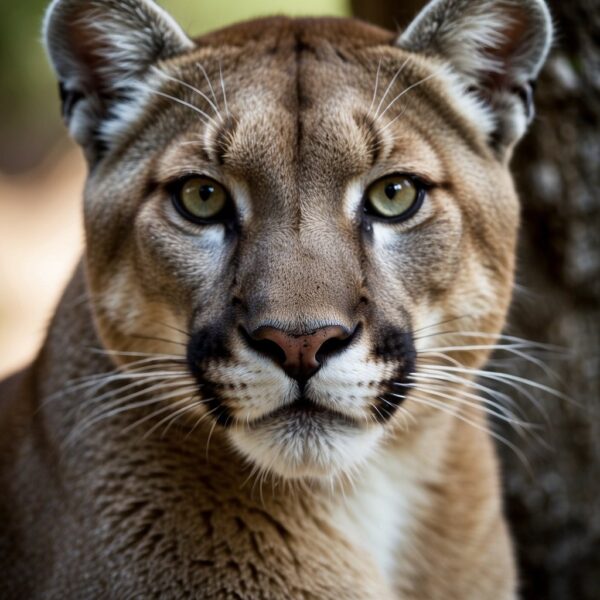
Frequently Asked Questions
Mountain lion screams are a rare but highly discussed aspect of their behavior due to the chilling quality of the sound. This section addresses common inquiries related to the vocalizations of these elusive creatures.
Why do mountain lions scream?
Mountain lions use screams during mating season as a means to communicate with potential mates. These vocalizations are a vital part of their reproductive behavior.
Can mountain lions vocalizations be mistaken for human screams?
Yes, mountain lions can produce high-pitched screams that are sometimes mistaken for a human in distress. Their screams can vary in intensity and pitch, leading to confusion.
What does a mountain lion scream sound like?
A mountain lion’s scream is a startling, high-pitched noise that may resemble a human scream. The sound is powerful and can carry over long distances in the wild.
When are mountain lions most likely to scream?
They are most likely to scream during the breeding season, which peaks in winter but can occur at any time of year. Screams are less commonly heard outside of this season.
Are there different vocalizations a mountain lion makes and what do they signify?
Mountain lions emit different sounds such as growls, hisses, and purrs. Growls are typically a warning, hisses can signal aggression or defense, and purrs usually occur between a mother and her cubs.
How can you distinguish between a mountain lion scream and other animal sounds?
Distinguishing a mountain lion scream from other animal noises requires paying attention to the pattern and pitch. Mountain lion screams are prolonged and powerful, unlike the noises made by most other wild animals.